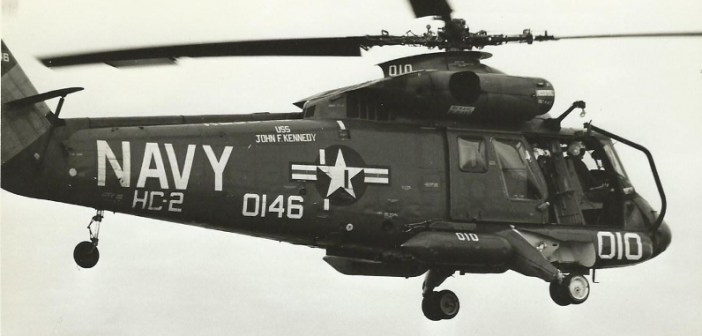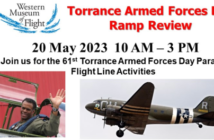On the way over to the Med, the U.S.S. John F. Kennedy (CV-67) was plowing through the water at an economical twelve knots, when the Air Transport Officer a.k.a. the ATO called our ready room. His purpose in life was managing the arrival and departure of people and cargo to and from the carrier on airplanes we referred to as “the COD.” COD – short for carrier on board delivery – was a twin engine turboprop that brought the battlegroup stuff when we weren’t in port, some of which was distributed to the other ships in the battle group by helo.
ATO – “How far can one of our H-2s fly?”
Me – “One way or round trip?”
ATO – “One way.”
Me – “Two hundred miles with reasonable winds.” I didn’t tell him that distance gives the crew roughly a thirty minute reserve which really means the HH-2D could fly 250 miles, one way.
The ATO hung up apparently satisfied with my answer. We were all puzzled because our detachment provided both his office and the Combat Information Center or CIC a card with the HH-2D’s range, passenger and cargo capacity.
Ten minutes later, the phone rang again. It was the ATO saying we’re to launch as soon as possible to fly a sailor going on emergency leave to Naval Air Station, Rota located in southwestern Spain. There, the young man would catch a P-3 flying to NAS Brunswick which was just an hour from his home. After we refueled at Rota, we were supposed to bring a different passenger and several bags of mail back to the Kennedy.
While we were strapping in, the ATO handed me a card that had our emergency leave sailor’s name, his weight, the weight of his sea bag and the five bags of mail. The card said Rota was 180 nautical miles at 080 degrees from the carrier.
Back then, GPS was a gleam in someone’s eyes and ship inertial navigation systems weren’t very precise. Celestial navigation was still the way ship’s determined their position with sightings every day. The course and distance given to us by the ATO was supposedly based on input from the ship’s navigator.
Rather than chug along at five-hundred feet, we climbed to five thousand feet for two reasons. Reason one: because the Kennedy could see us on their radar out to about fifty miles which was one third of the way to Rota. Rota’s radar would detect us at about the same distance so we would only be out of radar contact for about eighty miles. Reason two: because at five-thousand feet, we could pick up the Rota’s TACAN farther out, around seventy-five miles. At our max range airspeed of ninety knots, we would burn less fuel.
My co-pilot reported to the Kennedy when we were level at five thousand, headed zero-seven-five. The controller acknowledged our call and it was quiet in the helicopter. I was sure that in about thirty minutes we would see land. By heading zero-seven-five, if the crosswind was stronger than we planned, I hoped we would not miss the southern tip of Spain.
We were droning along enjoying the flight when the Kennedy’s Combat Information Center called. “Angel One-One, radar contact lost, pigeons to Rota are zero-eight-eight at one-ninety.” Translation, we can no longer see you on radar and the heading to fly to Rota is close to what we were flying but we had one hundred and ninety miles to go.
Huh?
We tuned our TACAN to the Kennedy’s frequency which indicated we were ninety miles from the carrier. Whatever happened to the original distance of one hundred and eighty nautical miles we were given?
My co-pilot called back to confirm the bearing and distance to Rota. We were asked to standby so we kept flying toward land as my mind raced with options.
We had a mission and needed to accomplish it, but there wasn’t a pilot in the water or in enemy territory to be rescued. We were just headed to Rota to drop off a sailor headed home on emergency leave and bring a passenger back to the Kennedy.
Combat confirmed the pigeons, i.e. the bearing and distance to Rota. My co-pilot was thumbing through a publication that listed all the military and civilian airfields in southwestern Portugal. The closest was Faro about sixty miles north of out track. As we didn’t have an ICAO flight plan, landing at a civilian airport unannounced could create problems. It might be made worse if we declared an emergency.
To save fuel, we dialed back the rotor rpm to one hundred per cent from the normal one-oh-two that we used. My co-pilot re-estimated how much fuel we had burned and how much we had left. We took off with twenty-four hundred pounds and at this altitude and speed we were burning eight hundred and fifty pounds an hour. Our fuel totalizer said we had just over a thousand pounds or about an hour and ten minutes of flying left before our engines flamed out. At ninety knots, our range was just over one hundred miles.
Could we have returned to the Kennedy? Absolutely! But ships are notorious for not being where they say they are. We already knew that there was a mistake in their position, at least how it was given to us. In a helicopter low on fuel, an error of fifteen or twenty miles could mean the difference of landing on a deck, a helipad or getting wet. Our best option was to find the shoreline and then find Rota. If worse comes to worse, we’d land in a farmer’s field or on the beach just before we ran out of fuel.
My co-pilot tuned the TACAN to Rota’s frequency and it showed we were eighty miles out. He called Rota’s approach control, gave them our position and told them we were low state. At fifty nautical miles, the low fuel light came on, telling us we had two hundred pounds. Barely enough to get to Rota – maybe!
When we spotted the air station, less than a mile or so inland, my co-pilot and I breathed easier. The low fuel light was staring me in the face and we told the tower we were going to land on the numbers.
At five miles, I started a gentle descent to one thousand feet where we would stay until we had the runway made so if the engines flamed out, I could autorotate to a runway. When we were cleared to land on the helipad by base operations, my co-pilot responded by saying that we were landing on the parallel taxiway and may need a tow to get to the ramp. His radio transmission was greeted with about thirty-seconds of silence before the controller rogered the call.
The H-2 touched down on the taxiway and those of us on the intercom all breathed a sigh of relief. As I eased the cyclic forward to taxi to base operations, the right engine began to unwind. Seconds later, the left one quit.
After being towed in, I went into base operations to look for our returning passenger. Waiting there was a crewman from the P-3 and soon, the enlisted man going on emergency leave took off for home. Our passenger, who was supposed to be waiting for us at the passenger terminal was not there. I called the BOQ and learned he wasn’t due for two days!
From base operations, I sent a message – this was before satellite telephones and emails – addressed to the ATO, with a copy to my detachment officer-in-charge that said, “Arrived safely in Rota. Emergency leave made flight. Return passenger not arriving for two days. Will fly aboard when ship arrives. Actual distance from ship to Rota was two-eight-zero.”
We tied down the blades and secured the refueled helicopter for the night. I told our two air crewmen the good news, we were spending the night at Rota and go have fun. We’d muster at 0800 at base operations. The bad news was that none of us had any civilian clothes, but that is what Navy Exchanges are for! Additional good news was we had a couple of beers and a steak on the Navy’s nickel and also charged Uncle Sam for a package of underpants and undershirts, a pair of jeans and a golf shirt. Toiletries were provided by the BOQ.
The Kennedy arrived late the next day. Once we landed on board, my first stop was to see the navigator who apologized profusely. He gave the ATO the ship’s anticipated position at midnight thirteen hours after we lifted off instead of its actual position.
The moral of the story is once again, never take a ship’s position for granted.




